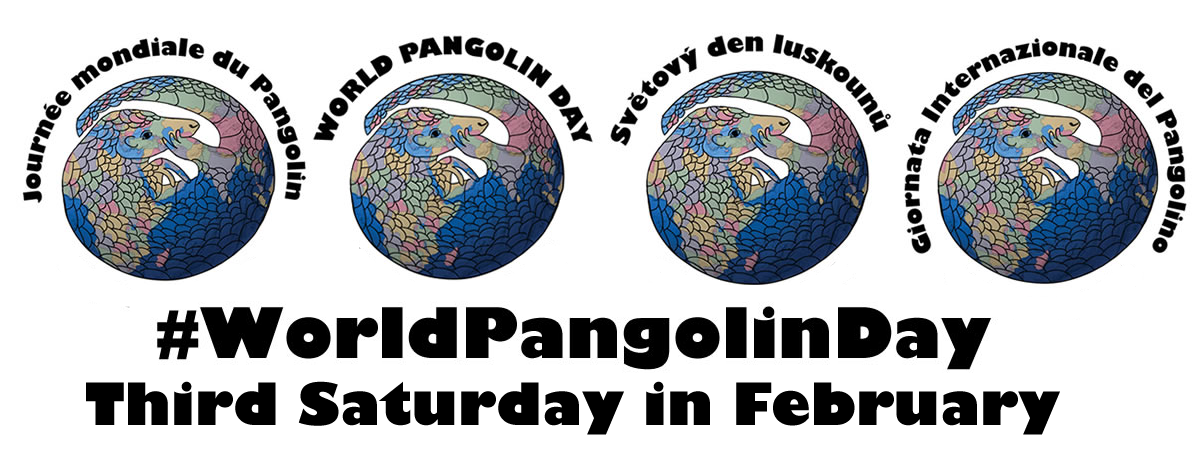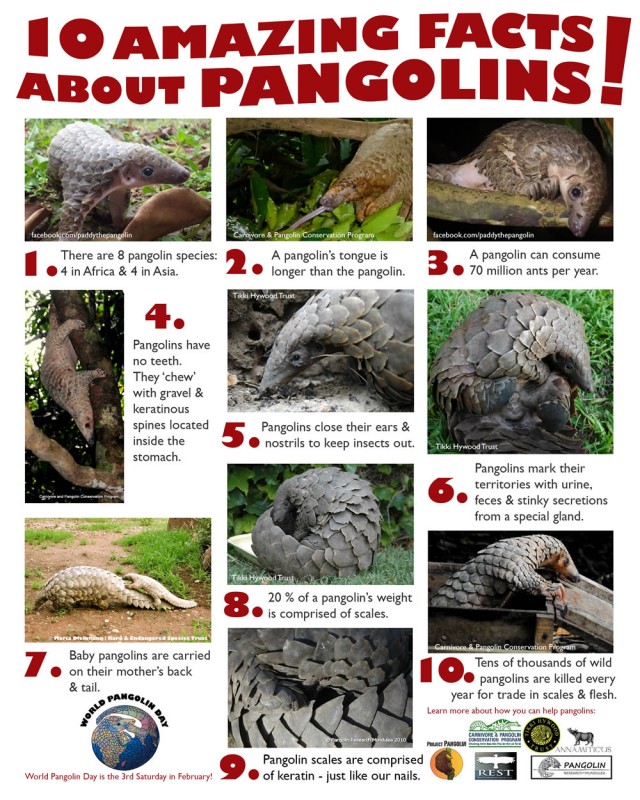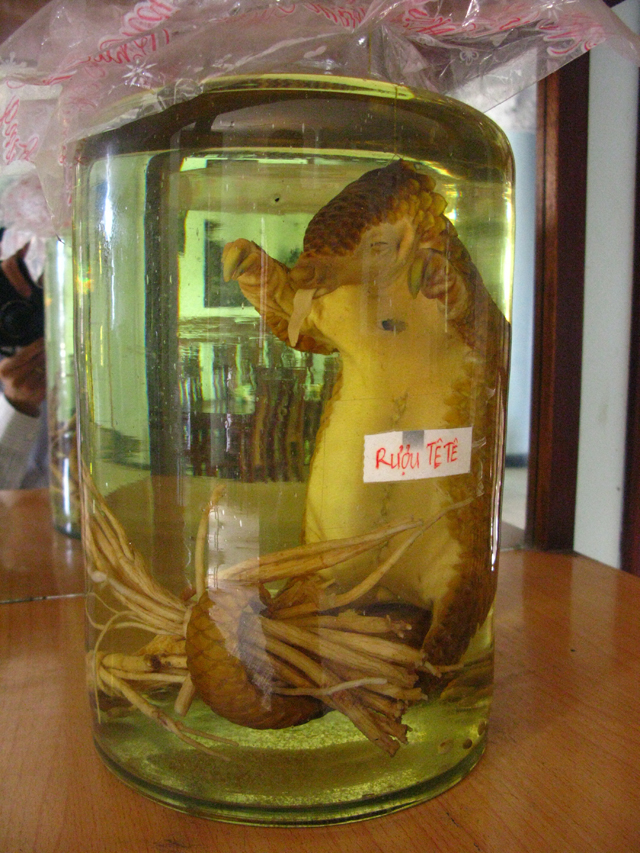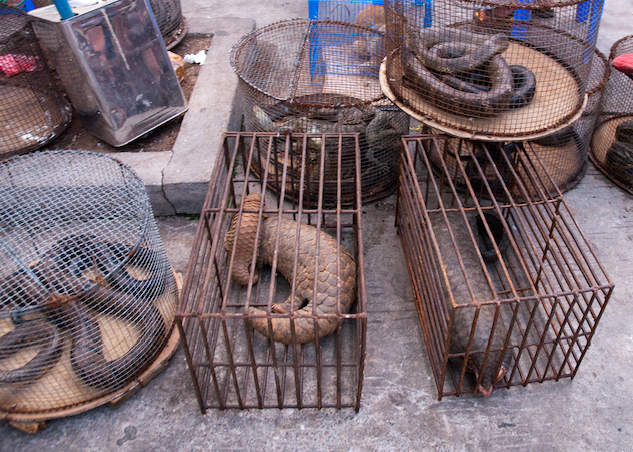Hong Kong customs seize record haul of pangolin scales, along with over 1,000 ivory tusks, bound for Vietnam
PUBLISHED FEB 1, 2019, 2:17 PM SGT
HONG KONG (REUTERS) - Hong Kong customs busted a massive endangered species smuggling operation from Africa, seizing a record quantity of pangolin scales along with more than 1,000 ivory tusks, as the authorities step up the fight against illegal wildlife trafficking.
The value of the seized goods - which equates to around 500 elephants and up to 13,000 pangolins - was over HK$62 million (S$10.7 million), officials said on Friday (Feb 1). Originating in Nigeria, the shipment was bound for Vietnam, they added.
In a separate incident, customs officials in the northern Vietnamese port of Hai Phong discovered another 1.4 tonnes of pangolin scales in a shipping container sent from Nigeria, the state-run Vietnam News Agency reported on Friday.
Last October, Vietnam intercepted more than more than eight tonnes of pangolin scales and ivory, also from Nigeria, in one of the South-east Asian country's largest wildlife trafficking cases for years.
The Chinese territory of Hong Kong, located on the country's southern coast, is a global blackspot for wildlife trafficking. The city is a key transit point, supplying an array of wildlife products including timber, shark's fin and rhino horn across Asia and particularly mainland China.
On Jan 16, customs seized about 8,300kg of pangolin scales and 2,100kg of ivory tusks at the Kwai Chung cargo port located in the former British colony.
It was the largest single seizure of pangolin parts in Hong Kong.
Mr Yeung Ka Yan, head of command at Hong Kong's Customs and Excise Department, said the smugglers used a new method to hide the endangered species by a process of "solidification" where they used ice bags and frozen meat to obscure the species.
"The low temperature environment created by the ice bags and frozen meat helped mask the distinctive smell of the pangolin scales."
Pangolins, also known as scaly anteaters, are critically endangered. They are coveted for their meat - considered a delicacy - and their scales, which are used in traditional Chinese medicine to treat ailments from cancer to arthritis.
"It is clearly impossible that the pangolin species can withstand such high rates of poaching, trafficking and trade. Eight tonnes is outrageous," said Mr Alex Hofford, campaign manager for conservation group WildAid in Hong Kong.
WildAid estimates 100,000 pangolins are poached from the wild each year, with all eight species of pangolin in Africa, and especially Asia, now under threat.
Customs officials who worked with their mainland counterparts to intercept the goods, found the species buried under frozen meat inside a refrigerated container.
Officials said two people had been arrested in connection with the case.
In a 2018 review released on Thursday (Jan 31), customs officials said there had been a 72 per cent increase in seizures of endangered species with the total volume of goods seized increasing more than three times.
ADM Capital Foundation, which focuses on environmental challenges across Asia, wrote in a January report that wildlife trafficking should be incorporated under Hong Kong's Organised and Serious Crime Ordinance (OSCO).
Doing so would provide "a powerful disincentive to wildlife criminals, and importantly, would prevent reinvestment of profits into further criminal activities," the report said.
Threats to Pangolins & Pangolin Conservation
- Lisbeth
- Site Admin
- Posts: 65866
- Joined: Sat May 19, 2012 12:31 pm
- Country: Switzerland
- Location: Lugano
- Contact:
Re: Pangolin Poaching
"Education is the most powerful weapon which you can use to change the world." Nelson Mandela
The desire for equality must never exceed the demands of knowledge
The desire for equality must never exceed the demands of knowledge
- RogerFraser
- Site Admin
- Posts: 5069
- Joined: Wed Sep 18, 2013 9:36 pm
- Country: South Africa
- Location: Durban
- Contact:
Re: Pangolin Poaching
World Pangolin Day 2019
Rod Cassidy
Published on Apr 22, 2018
Oko the white bellied Pangolin Rescue rolling in the mud and loving it.Who says Animals dont play??
Rod Cassidy
Published on Apr 22, 2018
Oko the white bellied Pangolin Rescue rolling in the mud and loving it.Who says Animals dont play??
- Lisbeth
- Site Admin
- Posts: 65866
- Joined: Sat May 19, 2012 12:31 pm
- Country: Switzerland
- Location: Lugano
- Contact:
Re: Pangolin

Meet the Pangolin!
New to pangolins? Start here and watch the video!
https://youtu.be/YuwPfP9G4Z0
Pangolins are considered one of the world’s most heavily trafficked mammal. These defenceless little beings are being slaughtered to extinction – simply to meet a demand based on superstitions and exploited by greed. Experts warn that the illegal trade in pangolins will render them extinct within our lifetime – yet most people have never heard of a pangolin!
It is estimated that more than 100,000 pangolins have been victims of the illegal wildlife trade since 2011.

Test your pangolin knowledge with 25 amazing pangolin facts:
1. There are a total of eight species of pangolin on our planet. Four live in Asia:
- Indian Pangolin (also called Thick-tailed Pangolin), Manis crassicaudata — ‘Endangered’
- Phillipine Pangolin, Manis culionensis — ‘Endangered’
- Sunda Pangolin (also called Malayan Pangolin), Manis javanica — ‘Critically Endangered’
- Chinese Pangolin, Manis pentadactyla — ‘Critically Endangered’
Four others live in Africa:
- White Bellied Tree Pangolin (also called Three-cusped Pangolin), Phataginus tricuspis — ‘Vulnerable’
- Giant Ground Pangolin, Smutsia gigantea — ‘Vulnerable’
- Ground Pangolin (also called Temminck’s Pangolin), Smutsia temminckii — ‘Vulnerable’
- Bellied Tree Pangolin, Uromanis tetradactyla — ‘Vulnerable’
2. Pangolins, also known as scaly anteaters, are unique creatures that are covered in hard, plate-like scales. They are insectivorous (feeding on insects) and are mainly nocturnal. Their name, “pangolin”, is derived from the Malay word “pengguling”, which loosely translates to “something that rolls up”. Together, the eight species comprise their very own Order: Pholidota.
3. Though many may believe them to be related to anteaters, sloths, and armadillos, Texas A&M University’s Biology Department explains that they are actually thought to be most closely related to true Carnivores (Order Carnivora). However, their relationships to other animals are not clear.
4. According to the International Union for the Conservation of Nature (IUCN), virtually no information is available on population levels of any species of pangolin. These species are rarely observed due to their secretive, solitary, and nocturnal habits, and there has been little research on their population densities. However, all species are thought to be in decline, with some more rapidly so than others — particularly the Asian species.
5. Pangolins have large, curved claws that they use for excavating ant and termite nests, as well as for pulling bark off trees and logs to find their insect prey.
6. Pangolins’ scales are made of keratin, the same protein that makes up our own hair and nails, rhino horns, the “teeth” of baleen whales, and the claws of bears (and other clawed animals). Their scales cover the entire body from head to tip of tail — except for their undersides, which are covered with a few sparse hairs.
7. Scaly anteaters are said to reach sexual maturity after two years, and typically only give birth to a single young per pregnancy. Their gestation period is thought to last between 69–150 days, varying by species. When born, the babies weigh around 8-450 grams (about 3-16 ounces), depending on the species, and have soft scales that harden fairly rapidly. Young are usually weaned at around three months of age.
8. Special glands near the animal’s anus secrete a pungently odorous fluid that is used for marking its territory. Like many other animals, they also scent mark with their feces and urine.
9. The scales of these critters comprise about 20% of their total body weight.
10. When pangolins feel threatened, they curl up into a tight, almost impenetrable ball to protect their tender undersides. If caught, they will thrash about using their tail muscles. Because their scales have very sharp edges, they can slice the skin of a human or predator when they do this. They may also release the stinky fluid from their glands as a defense mechanism.

11. They do not have teeth and are unable to chew. Instead, they have long sticky tongues that they use to catch the insects they feed on.
12. Some species, such as the Long-tailed pangolin, have prehensile tails that help in climbing in trees and hanging from branches.
13. When the pangolin’s tongue is fully extended, it can be up to 16 inches (over 40 centimeters) longer than its entire body length! In fact in most species, their tongues actually start deep in their chest cavity, arising from the last pair of ribs, and are about a quarter inch (0.6 cm) thick.
14. The Chinese and the Sunda pangolins are the most endangered of all eight species. In the case of the latter, their numbers began to decline quite rapidly around 1990 and the population has been halved over just the last 15 years. The IUCN reports that Chinese pangolins have also been greatly reduced over this time period. Despite being protected by CITES, poaching is decimating these (and other) species.
15. These animals can voluntarily constrict their ears and nostrils to keep insects out while they are feeding.
16. The biggest threat to all pangolin species today is illegal, commercial hunting for human consumption. African species are largely hunted as bushmeat, but there also seems to be some regional use of their scales and other body parts in folk medicines and cultural traditions and rituals. In
China and Vietnam (the primary sources of demand for pangolins), the flesh of both adult and fetuses is considered a delicacy and some mistakenly believe they will be blessed with health benefits if they eat it. Their scales, blood, and other body parts are also widely used in traditional Chinese medicines (TCMs) and ‘health tonics’. There is mounting concern that African pangolins will increasingly be targeted to supply the burgeoning Far East demand for these animals, as Asian species’ populations continue to plummet toward extinction. In fact, recent events suggest this may already be happening.

17. Despite the fact that scientific studies have proven that keratinous body parts of other animals (e.g. rhino horns) are void of any medicinal or curative properties, many continue to consume pangolin scales as a TCM remedy for a wide variety of health problems, such as reducing swelling, promoting blood circulation, and stimulating lactation in breast-feeding women. More recently, rumors likely spawned by Chinese pangolin “farming” business ventures have falsely claimed pangolin-derived TCMs can even cure cancer. As a result of the black market demand for these animals, an estimated 41,000-60,000 pangolins were plundered from the wild in 2011 alone.
18. As these creatures lack teeth, stomach contents are ground with small pebbles to aid in digestion — kind of like a bird’s gizzard. Their lower stomach (the pyloric region) are also lined with strange spine-like protrusions that point inward toward the center of the organ.
19. Pangolins have poor vision and hearing, but their sense of smell is quite strong.
20. The illicit pangolin trade has become extremely lucrative. According to Environmental News Network, pangolins were worth around US $10 per kilo in the early 1990s and had soared to US $175 per kg by 2009. Wildlife Alliance’s Suwanna Gauntlett explained in an interview with Mongabay guest writer, Laurel Neme, that the going rate had reached a whopping US $200 per kilogram in 2011.
21. It’s believed that a single pangolin consumes more than 70 million insects per year. They eat ants and termites.
22. Some species find shelter in trees, while others live in underground burrows.
23. Baby pangolins travel around with their mothers by riding on the base of her tail.
24. Giant ground pangolins are the largest of all eight species. One was found to weigh 33 kilograms (72.6 pounds) — the largest pangolin ever recorded! Long-tailed pangolins are the smallest, weighing around 2-3 kg (about 4-6 pounds).
25. While some poachers kill the animal when they catch it, other times they may be kept alive by request from restaurants where they are destined for the dining table. A 2007 article in The Guardian quotes a Guangdong chef explaining the disturbing way in which the pangolins are prepared for the diners.
“We keep them alive in cages until the customer makes an order. Then we hammer them unconscious, cut their throats and drain the blood. It is a slow death. We then boil them to remove the scales. We cut the meat into small pieces and use it to make a number of dishes, including braised meat and soup. Usually the customers take the blood home with them afterwards.”
"Education is the most powerful weapon which you can use to change the world." Nelson Mandela
The desire for equality must never exceed the demands of knowledge
The desire for equality must never exceed the demands of knowledge
- Lisbeth
- Site Admin
- Posts: 65866
- Joined: Sat May 19, 2012 12:31 pm
- Country: Switzerland
- Location: Lugano
- Contact:
Re: Pangolin
Human ignorance and stupidity are without limits 
"Education is the most powerful weapon which you can use to change the world." Nelson Mandela
The desire for equality must never exceed the demands of knowledge
The desire for equality must never exceed the demands of knowledge
- RogerFraser
- Site Admin
- Posts: 5069
- Joined: Wed Sep 18, 2013 9:36 pm
- Country: South Africa
- Location: Durban
- Contact:
- Alf
- Posts: 10705
- Joined: Wed Nov 26, 2014 12:40 pm
- Country: south africa
- Location: centurion
- Contact:
Re: Pangolin
Yeah stupid humans 
All wild animals will be extinct if these stupid humans are not stopped
All wild animals will be extinct if these stupid humans are not stopped
Next trip to the bush??
Let me think......................
Let me think......................
- Lisbeth
- Site Admin
- Posts: 65866
- Joined: Sat May 19, 2012 12:31 pm
- Country: Switzerland
- Location: Lugano
- Contact:
Re: Pangolin Poaching
There might be a reason for this rolling around  Anyway animals play and how they play! Look at the monkeys and the baboons, the elephants, the impalas, the springboks, the squirrels etc. etc. Some of the older ones might not, but have a look at your grandmother, does she play?
Anyway animals play and how they play! Look at the monkeys and the baboons, the elephants, the impalas, the springboks, the squirrels etc. etc. Some of the older ones might not, but have a look at your grandmother, does she play? 
"Education is the most powerful weapon which you can use to change the world." Nelson Mandela
The desire for equality must never exceed the demands of knowledge
The desire for equality must never exceed the demands of knowledge
- Lisbeth
- Site Admin
- Posts: 65866
- Joined: Sat May 19, 2012 12:31 pm
- Country: Switzerland
- Location: Lugano
- Contact:
Re: Pangolins

China Proposes Ban on Pangolins in Traditional Medicine
BY LUCY PAPACHRISTOU - 11 MARCH 2019 - OCCRP
Members of the National People’s Congress, China’s legislature, announced a proposal to ban the use of pangolin products, the world’s most trafficked animal, in traditional Chinese medicine.

The Democratic Alliance for the Betterment of Hong Kong (DAB), a pro-Beijing conservative political party, released a series of 24 proposals for this year to be presented at the annual NPC sessions in March, which included the pangolin ban.
In addition to outright banning the use of those animals in traditional medicine, lawmakers are advocating for increasing “investment in the research and development of pangolin tablets substitutes” and “promoting the protection of pangolin resources.”
“The position taken by China’s lawmakers proposing a ban on the use of pangolins in TCM is an encouraging sign,” said Chris Hamley, Senior Pangolin Campaigner for the Environmental Investigation Agency, a UK-based NGO.
Pangolins, often referred to as “the scaly anteater,” are the only mammals entirely covered in scales. All eight species of pangolin—four are found in Africa and four in Asia—were granted protection under international law in early 2017, according to WildAid, a US-based environmental NGO.
A 2015 report by WildAid found that 70 percent of Chinese citizens surveyed believed pangolin scales could cure rheumatism, skin disorders and infections. They are also thought to cure cancer and arthritis.
China currently permits the legal use of pangolin scales in clinical treatment and in pharmaceutical manufacturing, and they are listed as an official drug in the Chinese Pharmacopoeia, according to WildAid.
The new proposal could have a significant impact on the fate of pangolins, 100,000 of whom are taken from the wild every year across Africa and Asia.
Early last month, authorities in the Malaysian province of Sabah discovered two high-volume facilities containing thousands of boxes of pangolin meat, the biggest such seizure in the country to date.
Also included in the 2019 proposals were a number of other pieces of environmental legislation: strengthening the fight against illegal fishing; banning the trade and use of rhinoceros and its products; improving the system of protected natural lands; and the “protect[ion][of]animals to promote environmental protection.”
Read original article here: https://www.occrp.org/en/27-ccwatch/cc- ... l-medicine
"Education is the most powerful weapon which you can use to change the world." Nelson Mandela
The desire for equality must never exceed the demands of knowledge
The desire for equality must never exceed the demands of knowledge


